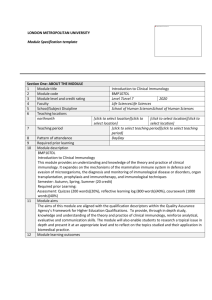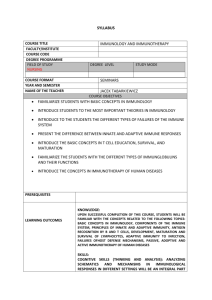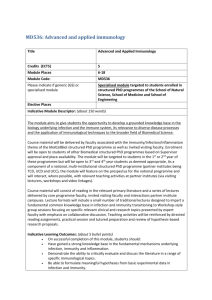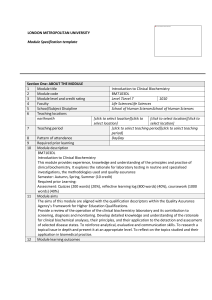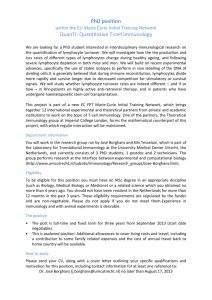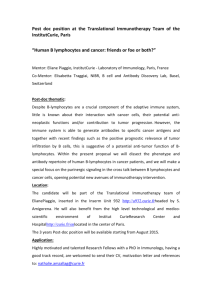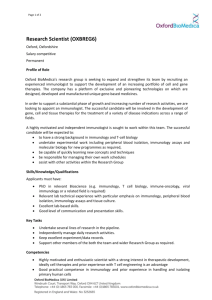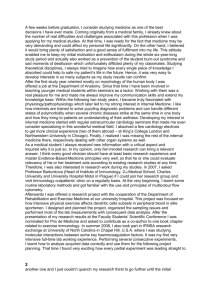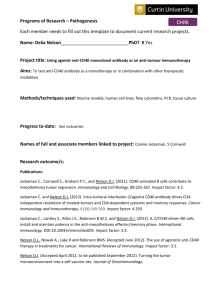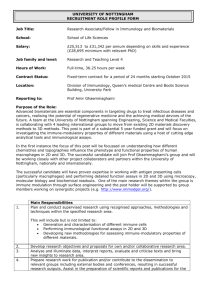BM7101DL: Introduction to Immunology
advertisement
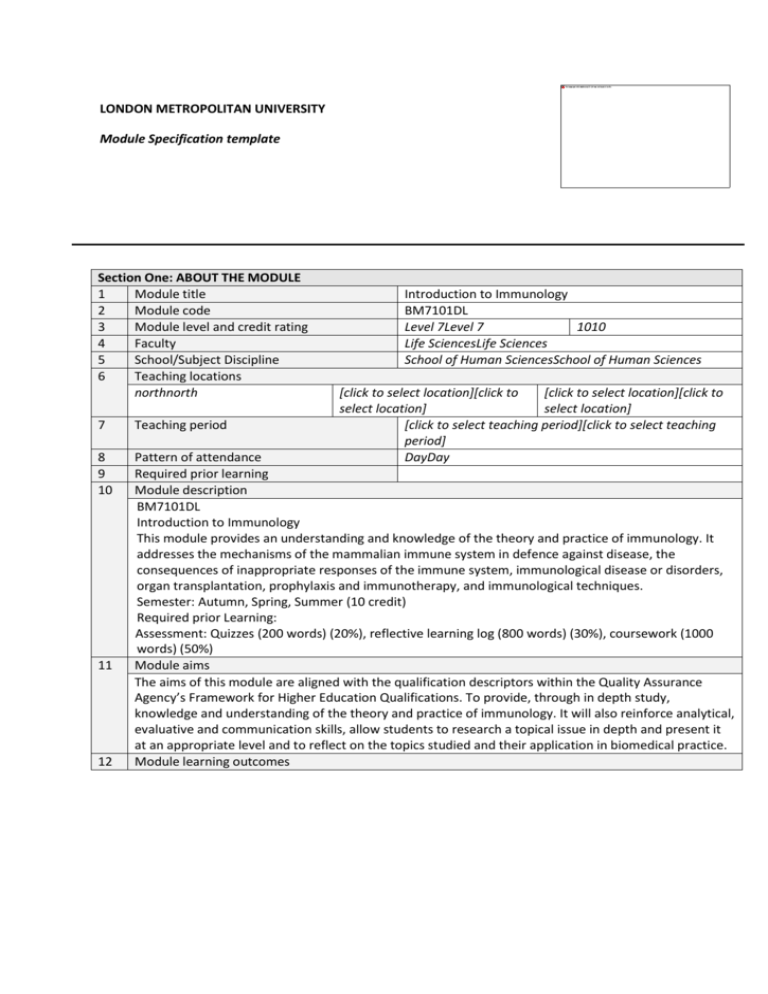
LONDON METROPOLITAN UNIVERSITY Module Specification template Section One: ABOUT THE MODULE 1 Module title 2 Module code 3 Module level and credit rating 4 Faculty 5 School/Subject Discipline 6 Teaching locations northnorth Introduction to Immunology BM7101DL Level 7Level 7 1010 Life SciencesLife Sciences School of Human SciencesSchool of Human Sciences [click to select location][click to [click to select location][click to select location] select location] [click to select teaching period][click to select teaching period] DayDay 7 Teaching period 8 9 10 Pattern of attendance Required prior learning Module description BM7101DL Introduction to Immunology This module provides an understanding and knowledge of the theory and practice of immunology. It addresses the mechanisms of the mammalian immune system in defence against disease, the consequences of inappropriate responses of the immune system, immunological disease or disorders, organ transplantation, prophylaxis and immunotherapy, and immunological techniques. Semester: Autumn, Spring, Summer (10 credit) Required prior Learning: Assessment: Quizzes (200 words) (20%), reflective learning log (800 words) (30%), coursework (1000 words) (50%) Module aims The aims of this module are aligned with the qualification descriptors within the Quality Assurance Agency’s Framework for Higher Education Qualifications. To provide, through in depth study, knowledge and understanding of the theory and practice of immunology. It will also reinforce analytical, evaluative and communication skills, allow students to research a topical issue in depth and present it at an appropriate level and to reflect on the topics studied and their application in biomedical practice. Module learning outcomes 11 12 13 14 15 16 17 On successful completion of this module students will be able to: 1. Demonstrate an understanding of the products of immunological responses, and the mechanisms of specific and non-specific defence and show an understanding of the consequences of inappropriate responses and malfunctions in the ontogeny of immune response components. 2. Demonstrate an ability to utilise immunological techniques as a member of a team to generate practical data to diagnose diseases and show an appreciation of current and evolving concepts in immunology and developments in immunotechnology, immunotherapy and immunoprophylaxis and 3. Think critically in analysing and solving immunological problems and demonstrate through the reflective learning journal that the student has reflected on their own performance as an independent professional learner Indicative syllabus – for full details see section C in Module Booklet Basis of immunity: historical perspectives; self /non-self behaviour of cells; comparative immunology; components and effector mechanisms of innate and non-specific immunity; specific immunity; ontogeny of effector mechanisms for primary and secondary responses; immunoregulation; Class I and II major histocompatibility (MHC) gene products. Pathology and immunotherapy: immune-mediated injury and disease; hypersensitivity, immunodeficiency, autoimmunity and immunopathology; tumour immunology; cancer immunotherapy; immunity to infection; transplantation immunology; immunosuppressive therapy; experimental systems and immunomodulation therapy. Immunotechnology: hybridoma technology; monoclonal antibodies and their biochemical and medical applications; vaccine design and production. Indicative bibliography and key on-line resources – for full details see section D in Module Booklet Alberts et al. (2008) Molecular Biology of the Cell 5th Ed. Garland Science. NY. Eales L. (2003) Immunology for Life Scientists. 2nd Ed. Wiley. Murphy K, Travers P, Walport M. (2008) Janeway's Immunobiology 7th Ed. Garland Science. NY. Lodish et al. (2008) Molecular Cell Biology 6th Ed. Freeman. NY. Learning and Teaching strategy for the module including approach to blended learning, students’ study responsibilities and opportunities for reflective learning/pdp Information pertaining to the subject matter will be presented through an integrated programme of lectures and supporting exercises, together with some use of a problem-based learning approach and the guided use of student-centred learning resources. Lectures will be used to provide a conceptual framework. Student centred assignments will enable students to reinforce and expand their knowledge, and develop subject specific skills and competence. Indicative learning and teaching hours for the module. Learning hours comprise face-to-face and virtual contact hours plus self-managed and directed learning and time spent on placements (where relevant). Method Description and percentage of learning hours Scheduled learning and teaching activities Guided independent study 100 (100%) TOTAL LEARNING HOURS FOR THE 100 MODULE Assessment strategy The module will be formatively assessed by in-course online quizzes (20%) and two coursework components. A reflective learning log (800 words) and a written assignment (30%; 1000 words). Criteria for assessment will include an understanding of the subject matter; an ability, both orally and written, to explain, describe and discuss the work; completeness and conciseness of written reports and essays with emphasis upon critical ability and scientific rigour. To pass the module students need to achieve a minimum aggregate mark of 50%. 18 19 Component Learning outcomes Quizzes 1 Reflective learning log 2,3 Written assignment 2,3 Arrangements for formative and summative feedback Written feedback on the coursework will be given at the end of the module Description of assessment items Assessment Method Practical ExamPractical Exam CourseworkCour sework CourseworkCour sework Description of Item % weighting Week Due On-line Quizzes (200 words) 20 Reflective learning log (800 words) 30 12 Written assignment (ECA) (1000 words 50 14 Section Two: FACULTY USE 20 Nominated External Examiner 21 Nominated Module Leader at time of approval 22 Courses to which this module contributes and whether Core or Option If not pass on aggregate, explain what is required to pass the module Sheelagh Heugh Section Three: OFFICIAL USE AND CODES – responsibility for completion is as indicated 23 Original date of approval (QEU) 24 Module approved to run from (QEU) 25 Revision date (specify cohort) (QEU) 26 Module specification version number (QEU) 27 SITS Mark Scheme (Academic Registry) 28 Subject Standards Board Name (Academic Registry)
